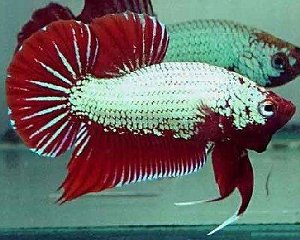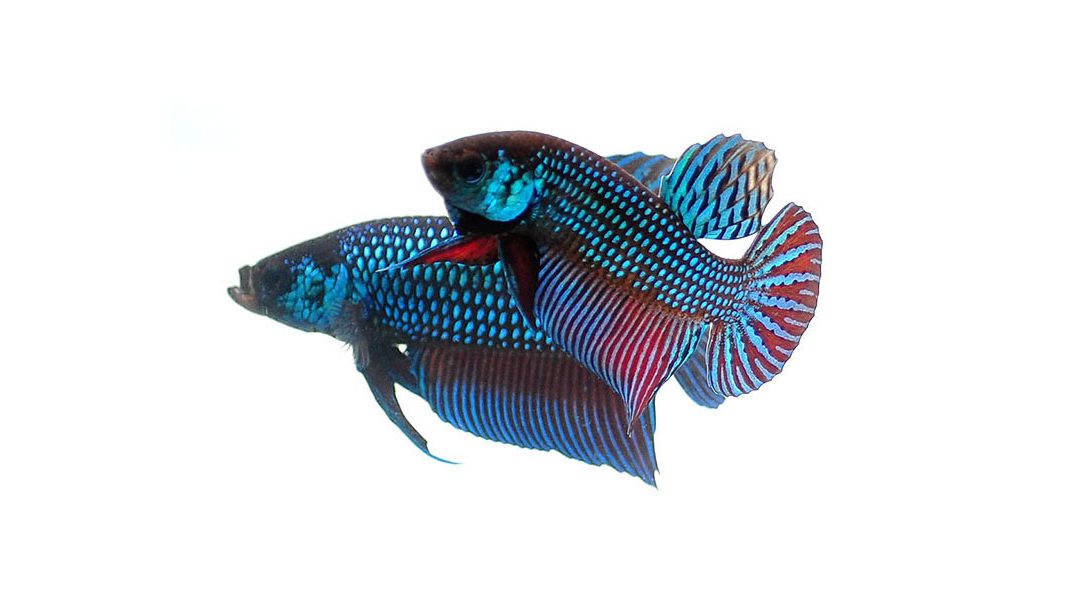 History of Fighting Betta Splendens
History of Fighting Betta Splendens
Wild bettas (fighter betta) originate from the tropics of SE Asia, Thailand, Malaysia and parts of Vietnam. Where children would collect them from the paddy fields and then pit them against each other for sport. In Thailand, the fish has been raised in households since the Sukhothai Period, more than 700 years ago. Records from the reign of King Lithai of Sukhothai allude to fighting fish being reared for sport. It was at this time the fish were developed for fighting prowess.
About fighting fish
It is the male bettas that fight each other. Male bettas may be aggressive to females and females may or may not be aggressive to each other. In a large aquarium with many hiding places many female bettas can be kept together.
Officially, It started in Siam some 180 years ago. The King of Siam started collecting, breeding and fighting them in the 1830s. The King of Siam in 1840 decided to license them and to collect taxes on them as well. He also presented several of his prized fighting fish to a friend of Theodor Cantor, and he, in turn, gave them to Cantor, a doctor in the Bengal Medical Service. In 1849, Cantor published an article on the fighting fish he called Macropodus pugnax, var. It was not until 1909 that Mr Tate Regan re-examined this and noted that pugnax was already a distinct species. Since the fish had no scientific name, Regan renamed it Betta splendens, according to Gene Wolfsheimer, author of Enjoy the Fighting Fish of Siam. Bettah is a tribe of warriors in Thailand famous for their warring prowess and Splendens means splendid.
The first fighter bettas were introduced into Germany in 1896. From there, bettas were first introduced into the US in 1910. However, it was not until 1927 that the first brightly colored, long finned betta varieties arrived in the US.
Ethics of Fighting Betta

Some say it is a cruel sport to provoke two male fighters to maliciously attack each other. Some say it is a cruel sport where fighters damage each other for the mere entertainment of its human audience. On a scale of cruelty it is less cruel than fox hunting and culling wild populations of animal pests such as rabbits or rats. Is it more cruel than exhibiting exotic breeds of dogs that have been bred with a genetic trait that is a genetic malformation such as small size, short legs, droopy ears, baldness or any of the other abnormalities? On the other hand the male bettas ability to fight another betta is an inbuilt instinct that nature has selected for it to fight rivals for territory and females. It could be argued that breeding for fighting ability is more ethical than breeding for colour or long flowing fins.
Fighting Bettas is no more and no less ethical than two professional boxers fighting.
To minimise any cruelty, rules have been developed that prevent ill or injured fish fighting and removing one or both fish when one fish has conceded defeat or no winner has been declared after a set time.
Betta fighting is entertaining and amazing to watch and is acceptable if done professionally. First of all, any fights to death are immoral, cruel, unnecessary, barbaric, and wrong. It is the difference between the modern day morally acceptable boxing and and the cruelty of the roman gladiator’s fight to the death. We are no longer cave men, and the time for acting as such has long since past. We may all responsibly enjoy betta fights without death or permanent injury if these simple guidelines are established and strictly enforced.
Selecting fighters

At present, fighter betta are developed for intelligence, attacking accuracy, endurance, power, courage, speed, strong lips and hard scales. Sharp teeth is one of the major factors in determining a winner.
Always try to select a smaller or weaker opponent if possible.
Fighter’s teeth can sharpen at different ages some younger some older.
Good fighter, like good boxers, will finish off an opponent given the opportunity. A fighter that lets his opponent off the hook will be liable to a comeback from his opponent. A good fighter will know where to attack an opponent.
Select a fish that looks strong and is aggressive. If you fish’s mouth show black or swelling than it is useless. You must select a big size, firm and strong fish. Always carefully select your opponent to increase your chance of winning making sure that your fish is more superior than its opponent. Never match your fish against a fish that has beaten it previously.
Looking after fighters
It is the same as looking after professional boxers. Provide fresh live protein. Exercise. Clean water conditions. Like prize fighters they are given a few days rest before a fight and their jars are shielded from all distractions while they are being fed the best quality food available. Mosquito larvae and caterpillars are ideal. A healthy fish is a strong and fast fish.
Training fighters
Train the fighting fish by exercising it every morning and evening.

Exercises include swirling the water for 15 minutes. Also placing two fighters in adjacent jars and swirling the water while they threaten towards each other while swimming is great fighting practice. Also placing a female in an adjacent jar will make them more aggressive and territorial.
Another exercise is to place a female fighter in the same jar as a male and watch the pair carefully for about 3 minutes. They will mostly threaten each other but may occasionally nip. If it looks like getting serious separate the pair.
Never put two males into the same jar as this will result in unnecessary minor injuries that need to heal.
Keep up this practice for 10 – 12 days. Those fish will be strong and ready to fight.
A small black tipped stick is used to test the fish’s aggressiveness. If it challenges the stick vigorously, this marks the end of the training phase. The fish is ready to fight.
The training phase typically lasts for 1 to 2 weeks.
When fish are ready for fighting, they should be given 2 to 3 days of rests. Bottles are shielded to minimize interruption to their rests. Complete shielding of the jar sides will rest the fish before any fights so that they don’t attack insects or distractions on the jar causing themselves unnecessary injuries.
Fighting rules

The fighting rules within countries of the South East Asian region differs, in Thailand there are no time limits, the fight will end only when there is a winner. (The loser is the fish that gives up the fight and flees). In Singapore and Malaysia, the time limit is usually set at 3 to 4 hrs. If there is no winner within that time then it is a draw.
At the fighting ring, fishes are matched for fights based on their physical size. They are put side by side and scrutinized, fish owners will then decide whether a fight should go ahead. A bigger fish is certainly a stronger fish, therefore it is critical to try and gain a size advantage before a fight begins.
Sizing is an art, hardcore players never give in and will try every means to look out for an advantage in size. Fishes also come in different dimensions, some are taller, others thicker when viewed from the top and last but not least the ratio of fishes’ head and body also differs. These all make sizing complicated.
Cheating is not uncommon in fights involving large bets, there are many tricks employed by unscrupulous players. Poisoning opponents’ fish is one example, in some arenas the top cover of bottles are sealed during sizing. Replacing the fishes after sizing with a similarly colored but bigger fish is also common. Last but not least the bottles also play tricks, some bottles give the illusion of a smaller fish due to the design of the glass, but when thrown into the fight bottle the fish becomes bigger.
It is very easy to humanely referee a betta fight. There are only 2 major guidelines so it is much easier then refereeing a human fight
The following guidelines will ensure a professional fight. As long as these are followed, and an honest referee judges the fight then betta fighting is perfectly safe.
Guidelines:
1. Injury. In the beginning of fight a single bite does not do much damage, but repeated attacks on the same spot can become serious. So fights must be stopped BEFORE permanent damage. As soon as a torn fin or skin damage occurs fight must stop. So it is imperative to stop fight as soon as either opponent sustains minor injury.
2. If a betta refuses to fight as an active aggressor but turns to escape or look for retreat, then he is considered a loser and the fights must be stopped immediately. The fish still actively pursuing the opponent is declared the winner.
Starting and closing fighting ring time:
- Open ring 8.30 am close the ring 5.30 pm
- Fight before 12.00 end the game at 3.30 pm
- Fight after 12.00 end the game 5.30 pm
General rule in fighting fish ring:
- Whoever opens the cap of the fighting jar means surrendered the fight.
- Each player has a chance of change fighting jar with new water within 10 minutes after fight.
- Moving a fighting jar is under the judge’s consideration alone.
- After putting a fighter in the fighting jar, a player should never touch the jar.
When to Stop a Match and Declare a Winner
Wining and losing:
- Owner of the fighter surrenders by opening the cap of the fighting jar.
- One fighter runs away and the owner surrenders.
- Referee fish trial and judge declares the trial result.
- If both fighters run away, draw if agreed or a referee fish can be used to make a decision.
Drawing:
- When both players agree to draw in any stage of the contest.
- When both players use referee fish on opponent two times and both fighters flare gills each time.
Use of a Referee Fish
Both players have a common right to call for a referee fish trial. A player may call the judge to use referee fish to examine both fighters to win the game early. When both fighters have completely stopped fighting, a judge will examine the fight. If both fighters do not hit one another then he will trial both fighters with a referee fish.
Trial by the referee fish:
A fighter must flare both sets of gills fully on approaching the referee fish.
Opening one set of gill or half flared gills or not approaching the referee fish is a fail.
Both players have an equal right to call judge for referee fish trial.
A player may call the judge to watch his fighter to see if he is eligible to call for a single trial of the opponent’s fish.
Single trial of 1 minute duration:
- To claim a single trial the caller’s fish must flare gills approaching the opponent fully.
- If an opponent fighter express an action willing to fight. Then the caller claim is null.
- If a caller’s fish flares gills when approaching the opponent fish and the opponent fish doesn’t react to fight, then a judge takes that opponent fighter to a single trial with a referee fish.
- A caller may call the judge to check opponent fighter continuously two times. If he fails then he has to wait 5 minutes for his next call. But the other player keeps his right to call.
- Each player has two chances to call for single examination. If opponent fighter flares gills towards referee fish fully before five hits, then both fighters fight again in a new jar.
How to Conduct a Single Trial of One Fish:
- A judge places a fighter to a trial jar.
- A referee fighter is placed in the same jar.
- A judge watches only from above.
- If a fighter flares his gills approaching the referee fish within 5 strikes by referee then he passes the trial otherwise he fails the trial.
- Both fighters fight again in a new jar when he passes the trial.
- Each player has a common right to call the judge single trial 2 times.
Match Trial of Both Fish by Referee fish:
- The two fighters are removed to two separate jars
- The referee fish’s jar is placed in the middle.
- Cardboard is placed all around the referee fish’s jar.
- The two fighter’s jars are placed either side of the referee fish.
- The judge adjusts the water level of all 3 jars to be level.
- The judge sets up the clock for 2 minutes.
- The cardboard is removed completely so the fish can see each other.
- The judge watches the flared gills of the fighters from above only.
- If one fighter flares gills and approaches to the referee fish, the judge declares “flared gills”. He then shifts this fighter to another jar and checks the other fighter.
- If the other fighter does not flare the gills and approach the referee fish, the judge spoon it out for a single trial.
- Each player can call for referee fish trial 2 times. If a fighters flare gills and approaches referee fish two times during the trial then that player has no right further trials. But the other player still has a right to call for a trial.
- If both fish do not flare gills then continue the game of fighting the same jar.
- If both flare gills approaching the referee fish then continue the fight in a new jar (new water).
- A player may call the judge to check an opponent fighter that ran away. If the judge sees a fighter running away, he will take the fighter to single trial. If a fighter shows it’s willingness to fight with trial fish then the game is drawn.
- If both fighters still fight to the end of fighting time, the judge will take each fighter to examine with the referee fish by single examine.
- One flares gills = win
- Both flare gills = draw
- Both do not flare gills = draw
The judge is a key man in the fighting ring. The main factor to run fighting fish ring successfully is depend very much on the fairness of judge.
A fighting ring judge must:
- not have fish that fight in the ring.
- not put direct bet or side bet in the ring.
- be fair and not take sides.
- not express personal opinion during doing duty.
